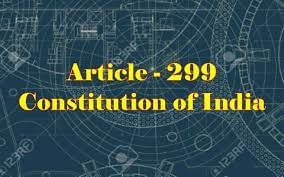UPSC Daily Current Affairs- 4th June 2023 | Current Affairs & Hindu Analysis: Daily, Weekly & Monthly PDF Download
GS-I
India rethinking its anaemia policy
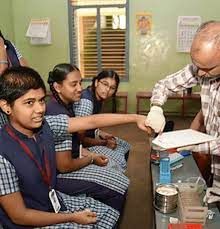
Why in News?
Questions related to anaemia are slated to be dropped from the National Family Health Survey (NFHS-6) scheduled to begin on July 6.
- The omission comes after health experts questioned the efficacy of the method being used to estimate haemoglobin levels.
National Family Health Survey (NFHS):
- The National Family Health Survey (NFHS) is a large-scale, multi-round survey conducted in a representative sample of households throughout India.
- The first National Family Health Survey (NFHS-1) was conducted in 1992-93. Subsequent NFHS’ were conducted as below –
- NFHS-2 was conducted in 1998-99
- NFHS-3 was conducted in 2005-06
- NFHS-4 was conducted in 2015-16
- NFHS-5 was conducted in 2019-21
- The main objective of the NFHS has been to provide reliable and comparable data relating to health and family welfare and other emerging areas in India.
- All the rounds of NFHS have been conducted by the International Institute for Population Sciences (IIPS), Mumbai, as the national nodal agency.
- Nodal Ministry: Ministry of Health & Family Welfare
News Summary
Anaemia
- About
- According to the World Health Organization (WHO), anaemia is a condition in which the number of red blood cells or the haemoglobin concentration within them is lower than normal.
- Haemoglobin is needed to carry oxygen.
- If there are too few red blood cells, or not enough haemoglobin, there will be a decreased capacity of the blood to carry oxygen to the body’s tissues.
- This results in symptoms such as fatigue, weakness, dizziness and shortness of breath among others.
- Factors
- The most common nutritional cause of anaemia is iron deficiency although deficiencies in folate, vitamins B12 and A are also important causes.
- Certain chronic diseases, such as kidney disease, liver disease, cancer, or autoimmune disorders, can interfere with the production of red blood cells.
- Inherited conditions, such as sickle cell anemia or thalassemia, affect the structure or function of red blood cells, leading to chronic anemia.
India’s anaemia burden
- India’s anaemia burden has grown alarmingly with NFHS-5 (2019-21) finding that:
- 57% of women in the age group 15-49 and
- 67% children between six months and 59 months are anaemic (from the corresponding 53% and 58.6% respectively in NFHS-4 (2015-16)).
- The Health Ministry has noted that anaemia is a public health challenge.
What prompted the change?
- WHO cut-offs for haemoglobin may not be suited to India
- The WHO defines:
- anaemia in children aged under five years and pregnant women as a haemoglobin concentration <110 g/L at sea level, and
- anaemia in non-pregnant women as a haemoglobin concentration <120 g/L.
- Experts had cautioned that there is a danger of anaemia being over-diagnosed in India as it follows WHO cut-offs for haemoglobin.
- This may not be suited to India, because the cut-off point depends on the age, gender, physiological status, altitude and other factors.
- The WHO defines:
- Differences in the way blood is drawn for sampling in NFHS
- Various studies also pointed to differences in the way blood is drawn for sampling in NFHS.
- The NFHS survey measured haemoglobin in a drop of capillary blood that oozes from a finger prick.
- This, as per the report, can dilute the blood and give a falsely lower value.
- The recommended method of venous blood sampling, as per the report, gives a more accurate value.
Shift in assessment of anaemia in India
- According to the Health Ministry, assessment of anaemia in India is being shifted to the new Diet and Biomarkers Survey in India (DABS-I).
- DABS-I was launched in December 2022 to map diet, nutrition and health status and provide the correct estimate of anaemia among the rural and urban population.
- The survey will define food and nutrient adequacy by collecting individual dietary intake data of different age groups of people.
- The study will also provide nutrient composition data on cooked and uncooked foods from various regions of the country for the first time.
Why the focus is on anaemia?
- Data on anaemia remains an important indicator of public health due to following reasons:
- Impact on morbidity and morality
- Anaemia is related to morbidity and mortality in the population groups usually considered to be the most vulnerable — pregnant women and children under five.
- Effect on reproductive health
- A prevalence study on anaemia is useful to monitor the progress of reproductive health.
- Impact on economy
- Also, iron-deficiency anaemia reduces the work capacity of individuals and entire populations, with serious consequences for the economy and national development.
- Impact on morbidity and morality
Source: The Hindu
Oil Reserves in salt caverns: The Potential in India
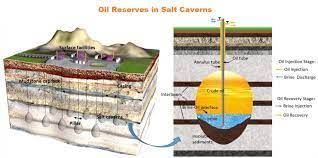
Why in News?
Government-owned engineering consultancy firm Engineers India (EIL) is studying the prospects and feasibility of developing salt cavern-based strategic oil reserves in Rajasthan, in line with the government’s objective of increasing the country’s strategic oil storage capacity.
What are salt caverns?
- Salt caverns are artificial cavities in underground salt formations, which are created by the controlled dissolution of rock salt by injection of water during the solution mining process.
How is it different from rock caverns?
- Unlike underground rock caverns, which are developed through excavation, salt caverns are developed by the process of solution mining, which involves pumping water into geological formations with large salt deposits to dissolve the salt.
- After the brine (water with dissolved salt) is pumped out of the formation, the space can be used to store crude oil.
- Also, unlike rock caverns, salt cavern-based storage can be created and operated almost entirely from the surface.
Benefits Salt Cavern
- The process is simpler, faster, and less cost-intensive than developing excavated rock caverns.
- Salt cavern-based oil storage facilities are also naturally well-sealed, and engineered for rapid injection and extraction of oil.
- This makes them a more attractive option than storing oil in other geological formations.
- The salt that lines the inside of these caverns has extremely low oil absorbency, which creates a natural impermeable barrier against liquid and gaseous hydrocarbons, making the caverns apt for storage.
- Salt caverns are also used to store liquid fuels and natural gas in various parts of the world.
- They are also considered suitable for storing compressed air and hydrogen.
Indian Scenario
- Countries build strategic crude oil reserves to mitigate major supply disruptions in the global supply chain.
- India, the world’s third-largest consumer of crude, depends on imports for more than 85% of its requirement — and strategic petroleum reserves (SPR) could help ensure energy security and availability during global supply shocks and other emergencies.
- India currently has an SPR capacity of 5.33 million tonnes, or around 39 million barrels of crude, that can meet around 9.5 days of demand.
- The country is in the process of expanding its SPR capacity by a cumulative 6.5 million tonnes at two locations — Chandikhol in Odisha (4 million tonnes) and Padur (2.5 million tonnes).
- India’s strategic oil reserves come under the Petroleum Ministry’s special purpose vehicle Indian Strategic Petroleum Reserve (ISPRL).
- EIL was instrumental in setting up the country’s existing SPR as the project management consultant.
- The International Energy Agency (IEA) in which India is an ‘Association’ country, recommends that all countries should hold an emergency oil stockpile sufficient to provide 90 days of import protection.
- In India, apart from the SPR that are sufficient to meet 9.5 days of oil requirement, the oil marketing companies (OMCs) have storage facilities for crude oil and petroleum products for 64.5 days — which means there is sufficient storage to meet around 74 days of the country’s petroleum demand.
Potential and Related Developments
- Rajasthan, which has the bulk of requisite salt formations in India, is seen as the most conducive for developing salt cavern-based strategic storage facilities.
- India’s strategic oil reserves are part of the effort to build sufficient emergency stockpiles on the lines of the reserves that the US and its Western allies set up after the first oil crisis of the 1970s.
- The three existing rock cavern-based facilities were built during the first phase of the programme.
- India has also decided to commercialise its strategic petroleum reserves, as part of which the Abu Dhabi National Oil Company (ADNOC) stored about 0.8 million tonnes of crude oil in the Mangaluru strategic reserve.
- Taking advantage of low crude oil prices in April-May 2020, the government completely filled these reserves, leading to estimated savings of around Rs 5,000 crore.
- In 2021, India released 5 million barrels from its strategic reserves as part of a coordinated US-led action by major oil consuming countries against the joint decision of major oil producing nations to curb output.
Challenges
- No Indian company, including EIL, had the requisite technical know-how to build salt cavern-based strategic hydrocarbon storage.
- This gap in access to technology has been bridged by EIL’s recent partnership with Germany’s DEEP.KBB GmbH — a company that specialises in cavern storage and solution mining technology — Shukla said.
- However, it is still too early to identify a specific site or make an estimate of the project cost.
Future Prospects
- Salt cavern-based storage, which is considered cheaper and less labour- and cost-intensive than rock caverns, could add a new, much-needed chapter to India’s SPR story.
- If the idea comes to fruition, India could get its first salt cavern-based oil storage facility.
- The country’s three existing strategic oil storage facilities — at Mangaluru and Padur in Karnataka, and Visakhapatnam in Andhra Pradesh — are made up of excavated rock caverns.
Source: Indian Express
GS-II
Article 299
Why in News?
Recently, the Supreme Court gave judgement on the claims of immunity while entering into a contract in the President’s name under Article 299 of the Constitution.
About Article 299:-
- Article 298 grants the Centre and the state governments the power to carry on trade or business, acquire, hold, and dispose of property, and make contracts for any purpose.
- Article 299 delineates the manner in which these contracts will be concluded.
- Article 299 of the Constitution provides that “all contracts made in the exercise of the executive power of the Union or of a State shall be expressed to be made by the President or by the Governor of the State” and that all such contracts and “assurances of property made in the exercise of that power shall be executed” on behalf of the President or the Governor by persons in a manner as directed and authorised by them.
- The phrase ‘expressed to be made and executed’ under Article 299 (1) means that there must be a deed or contract in writing and that it should be executed by a person duly authorised by the President of the Governor on their behalf.
- As per the ‘Chatturbhuj Vithaldas Jasani v. Moreshwar Parashram & Ors’(1954), there must be a definite procedure according to which contracts must be made by agents acting on the government’s behalf; otherwise, public funds may be depleted by unauthorized or illegitimate contracts.
- It implies that contracts not adhering to the manner given in Article 299(1) cannot be enforced by any contracting party.
- Article 299 (2) says that essentially, neither the President nor the Governor can be personally held liable for such contracts.
Source: Indian Express
Retain Sedition Law with Amendments: Law Commission
Why in News?
The Law Commission of India has recommended against the total repeal of sedition law (Section 124A of the Indian Penal Code) and has instead proposed that the provision be retained with certain amendments.
Highlights of the report submitted:
- The report highlighted that the offense of sedition is frequently regarded as a remnant of colonial rule, established during a time when it was frequently employed against India’s freedom fighters.
- The Commission suggested that a provision analogous to Section 196(3) of the Code of Criminal Procedure, 1973 (CrPC) may be incorporated as a proviso to Section 154 of CrPC, which would provide the requisite procedural safeguard before the filing of an FIR with respect to an offence under Section 124A of IPC.
About Sedition Law:
- Sedition laws were enacted in 17th century England when lawmakers believed that only good opinions of the government should survive, as bad opinions were detrimental to the government and monarchy.
- The law was originally drafted in 1837 by Thomas Macaulay, the British historian-politician, but was inexplicably omitted when the Indian Penal Code (IPC) was enacted in 1860.
- Section 124A was inserted in 1870 by an amendment introduced by James Stephen when it felt the need for a specific section to deal with the offence.
- Today the Sedition is a crime under Section 124A of the Indian Penal Code (IPC).
Section 124A IPC:
- It defines sedition as an offence committed when “any person by words, either spoken or written, or by signs, or by visible representation, or otherwise, brings or attempts to bring into hatred or contempt, or excites or attempts to excite disaffection towards the government established by law in India”.
- Disaffection includes disloyalty and all feelings of enmity.
- However, comments without exciting or attempting to excite hatred, contempt or disaffection, will not constitute an offence under this section.
Punishment for the Offense of Sedition:
- It is a non-bailable offence.
- Punishment under Section 124A ranges from imprisonment up to three years to a life term, to which a fine may be added.
- A person charged under this law is barred from a government job.
- They have to live without their passport and must appear in court at all times as and when required.
Need of continuation of Section 124A:
- Misuse of freedom of speech: Freedom of speech although is protected through Article 19 (1) but it is not unlimited.
- Sometimes speech is used as a tool to destabilise country polity and to promote enmity in society.
- The main reason behind the continuation of Sedition act after independence was to prevent the misuse of free speech (reasonable restrictions) that would be aimed at inciting hatred and violence.
- Internal security: Maoist insurgency and rebel groups virtually run a parallel administration; it would be dangerous to abolish it.
- These groups openly advocate the overthrow of the state government by revolution.
- Thus keeping section 124A is important for Indian security.
- Destabilising polity: Sometimes, propaganda and facts are modified and used to destabilise the country’s peace and polity by deliberately targeting government actions.
Arguments for Section 124A:
- Section 124A of the IPC has its utility in combating anti-national, secessionist and terrorist elements.
- It protects the elected government from attempts to overthrow the government with violence and illegal means.
- The continued existence of the government established by law is an essential condition of the stability of the State.
- Many districts in different states face a Maoist insurgency and rebel groups virtually run a parallel administration.
- These groups openly advocate the overthrow of the state government by revolution.
- Therefore, there is a need to retain the provision to effectively combat anti-national, secessionist and terrorist elements.
- The plea had contended that the provision which was used by the British against Mahatma Gandhi and Bal Gangadhar Tilak is still being “grossly abused” to stifle freedom of speech and expression of those who choose to express dissent against policies of the Governments in power.
Arguments against Section 124A:
- Mahatma Gandhi called Section 124A “the prince among the political sections of the IPC designed to suppress the liberty of the citizen”.
- Jawaharlal Nehru said that the provision was “obnoxious” and “highly objectionable”, and “the sooner we get rid of it the better”.
- It is a constraint on the legitimate exercise of constitutionally guaranteed freedom of speech and expression.
- Dissent and criticism of the government are an essential ingredient of robust public debate in a vibrant democracy.
- The British, who introduced sedition to oppress Indians, have themselves abolished the law in their country.
- There is no reason why India should not abolish this section.
- The sedition law is being misused as a tool to persecute political dissent. A wide and concentrated executive discretion is inbuilt into it, which permits the blatant abuse.
Way Forward:
India, being the largest democracy in the world, has to ensure its essential ingredients of free speech and expression. The expression or thought that is not in consonance with the policy of the government of the day should not be considered sedition.
It is also essential to protect national integrity. Given the legal opinion and the views of the government in favour of the law, it is unlikely that Section 124A will be scrapped soon. However, it should not be misused as a tool to curb free speech.
Source: Indian Express
Code of ethics and code of conduct for Civil Servants

Why in News?
There are some basic rules a civil servant needs to follow, and the limitations they are placed under.
About Civil Services:
- A civil servant is an official in the service of the people in a contemporary democracy who is recruited based on established criteria.
- Civil servants are officials who must be aware about the country’s laws and regulations and are expected to operate in the best interests of the nation and its citizens.
- According to the head of the Canadian Public Service, one of the most essential tasks of the public service is to “speak truth to power.”
- There are three All India Services (governed by Article 312 of the Indian Constitution) – the Indian Administrative Service, the Indian Police Service and the Indian Forest Service – which are selected by the central government with officers allotted to various state cadres.
- Other services are called Central Civil Services.
- These services are under the central government itself with no state cadre system.
- They include services such as the Indian Foreign Service, the Indian Revenue Service, Customs and Central Excise Service and several others.
Code of conduct for civil servants:
- “Conduct Rules,” a compilation of guidelines with “do’s and don’ts,” was released in the 1930s.
- According to the All India Services (Conduct) Rules, 1968, every member of the service shall maintain:
- Integrity and honesty;
- Political neutrality;
- Promoting the principles of merit, fairness and impartiality in the discharge of duties;
- Accountability and transparency;
- Responsiveness to the public, particularly to the weaker section;
- Courtesy and good behaviour with the public.
Code of ethics vs code of conduct rules:
- There is no ethical code for civil servants in India, despite similar standards exist in other nations.
- We have a set of guidelines that forbid a range of typical acts.
- These standards for behaviour have a function, but they are not a code of ethics.
- While the Conduct Rules provide basic guidelines such as “keeping integrity and unwavering commitment to duty,” the code of conduct is typically intended to list particular acts deemed inappropriate for civil servants.
- Recently, there has been some concern that additional “generic norms” should be added to the list of permitted conduct.
- In 2007, the Ministry of Personnel, Public Grievances, and Pensions published a draft “Public Service Bill” to establish a set of generic standards of civil servants known as “values.”
- The major “values” envisioned in the Bill are as follows:
- Allegiance to the various ideals enshrined in the preamble to the Constitution
- Apolitical functioning
- Good governance for the betterment of the people to be the primary goal of civil service
- Duty to act objectively and impartially
- Accountability and transparency in decision-making
- Maintenance of the highest ethical standards
- Merit to be the criteria in the selection of civil servants consistent, however, with the cultural, ethnic and other diversities of the nation
- Ensuring economy and avoidance of wastage in expenditure
- Provision of a healthy and congenial work environment
- Communication, consultation and cooperation in the performance of functions is the participation of all levels of personnel in management.
Issues with the Conduct Rules:
- Vague: For example, while the promotion of casteism is not covered under any specific Conduct Rules, casteiest behaviour can be interpreted as “unbecoming of a member of the Service”.
- Ambiguous: Ideas like personal integrity are not well defined. That is why evils like taking dowry are banned but seemingly common.
- There is no ethical code for civil servants in India.
Way Forward: Nolan Committee on Public Life Standards
The Committee on Standards in Public Life (CSPL) is a non-departmental British government advisory body established in 1994 to advise the Prime Minister on ethical standards in public life. They were as follows:
- Selflessness: People in positions of public trust should make decisions solely in the public interest.
- They should not do so in order to benefit financially or in any other way for themselves, their families, or their friends.
- Integrity: Public officials should not bind themselves financially or otherwise to outside individuals or organisations that could sway them in the performance of their official duties.
- Objectivity: Holders of public office should make decisions based on merit when carrying out public business, such as making public appointments, awarding contracts, or recommending individuals for rewards and benefits.
- Accountability: Public officials are responsible to the public for their decisions and actions, and they must submit to whatever scrutiny is appropriate for their position.
- Transparency: Public officials should be as transparent as possible about all of their decisions and actions.
- They should give reasons for their decisions and limit information only when it is clearly in the public interest.
- Honesty: Public officials have a responsibility to disclose any private interests that may conflict with their public duties and to take steps to resolve any conflicts in a way that protects the public interest.
- Leadership: Public officials should lead by example in promoting and supporting these principles.
Source: Indian Express
GS-III
What is Kavach System?
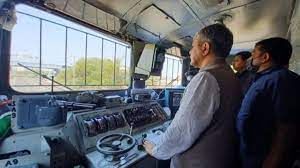
Why in News?
The railways recently confirmed that there was no ‘Kavach’ system installed on the trains involved in the accident in Odisha's Balasore district.
About Kavach System:
- It is an indigenously developed Automatic Train Protection (ATP) system.
- Kavach was developed by the Research Design and Standards Organisation (RDSO) under Indian Railway (IR) in collaboration with Medha Servo Drives Pvt Ltd, HBL Power Systems Ltd and Kernex Microsystems.
- It is a set of electronic devices and Radio Frequency Identification devices installed in locomotives, in the signalling system as well the tracks, that talk to each other using ultra-high radio frequencies to control the brakes of trains and also alert drivers, all based on the logic programmed into them.
- Since 2016, the railways have been carrying out field tests for Kavach on passenger trains.
- Applications:
- It has been designed to assist locomotive pilots in avoiding Signal Passing At Danger (SPAD) and overspeeding.
- The system can alert the loco pilot, take control of the brakes and bring the train to a halt automatically when it notices another train on the same line within a prescribed distance.
- The device also continuously relays the signals ahead to the locomotive, making it useful for loco pilots in low visibility.
- It also controls the speed of the train by an automatic application of brakes in case the loco pilot fails to do so.
- It helps the loco pilot in running the train during inclement weather conditions such as dense fog.
Source: Hindustan Times
Shanan Powerhouse
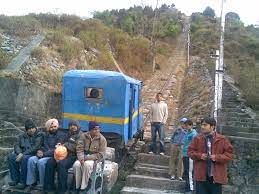
Why in News?
Himachal Pradesh Chief Minister recently handed over legal documents regarding Shanan Powerhouse to the Union Power Ministry.
About Shanan Powerhouse:
- Location: It is located in Joginder Nagar in the Mandi district of Himachal Pradesh.
- Commissioned in 1932, the powerhouse was constructed as per a 99-year lease executed between Raja Jogendra Sen, the then king of Mandi, and Col BC Batty, Chief Engineer of the Punjab Government, in 1925.
- This powerhouse was constructed against the backdrop of dense deodar forests.
- It is one of the oldest powerhouses of the country, which used to feed the entire undivided Punjab, Lahore and Delhi before Independence.
- After the reorganisation of states in 1966, the Shanan powerhouse was given to Punjab by the Centre as the lease agreement, signed in 1925 was yet to expire.
- The project originally was of 48 MW capacity, but the Punjab government enhanced its capacity to 60 MW in 1982. Later, 50 MW more was added to make its capacity 110 MW.
- The main attraction of the hydro project is the four-stage haulage trolley service. It was basically constructed for carrying construction material of Shanan powerhouse from Jogindernagar to Barot. It is a unique type of trolley based on pulley system with no engine, steering wheel or no gears or brakes.
Source: Hindustan Times
|
38 videos|5293 docs|1118 tests
|

